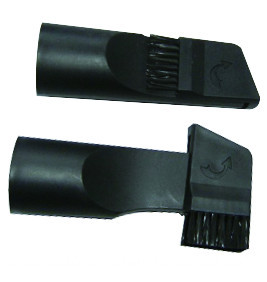Optical components The liquid crystal panel realizes the function and performance of a high-performance display by using a combination of optical components such as a plurality of films and sheets. Representative optical components include color filters, backlights, polarizers, phase difference plates, viewing angle expansion films, brightness enhancement films, and reflection sheets. The polarizing plate is a type of optical filter. The light is a vibration wave, and the polarizing plate passes only the light (polarized light) in a certain vibration direction. Two such filters are arranged at an angle of 90 degrees to each other according to the polarization axis, allowing light to pass or block light. The phase difference plate is a film that compensates for birefringent light generated when light passes through the liquid crystal layer by utilizing the phase difference of the film, thereby expanding the viewing angle of the liquid crystal panel. With the popularity of wide viewing angle technologies such as reflective, semi-transmissive, VA mode, and IPS mode, the role of phase difference plates has become more and more important. The viewing angle expansion film is one of the phase difference plates. The angle of view refers to the angle at which the screen is viewed. Generally, when the screen is viewed from the front and the screen is viewed from the oblique side, the image may be different. A film that expands this angle is a viewing angle expansion film. When the film is not used, the viewing angle at which a certain contrast can be obtained is at most 60 degrees above and below and 90 degrees at right and left. After the film is introduced, the image does not cause an uncomfortable feeling even if the angle of view is 125 degrees above and below and 130 degrees or more. Brightness enhancement film is a film used to increase the brightness of the screen. By using a film-shaped prism, the light that is incident in the oblique direction is concentrated to the front direction, thereby increasing the brightness of the front surface. The reflection sheet is a sheet that reflects light in the direction of the panel in order to efficiently use the light emitted from the light source. The biggest problem with the above various optical components is to reduce costs. Panel manufacturers and material manufacturers are working together to solve this problem. Low cost is developing in three directions. (1) The cost reduction of various films themselves, and also includes (2) how to reduce the film bonding process, and (3) how to use a low-cost method in film surface treatment, and the like. In the (2) reduction of the bonding process, various measures have been taken in the industry. For example, a phase difference plate of a reflective panel generally overlaps two films capable of processing two different wavelengths (1/2 wavelength and 1/4 wavelength), and also requires a polarizing plate to be attached. The price of the film itself is very expensive, and the cost of the paste is even greater. In order to reduce the bonding process, a technique of realizing the performance which can be obtained by combining different wavelengths with each other through a thin film (1/4 wavelength of reverse wavelength dispersion) has been developed. In addition, a representative product of the viewing angle-expanding film is a "WV film", and now the cost is reduced by integration with a protective film on the back surface of the polarizing plate. In the surface treatment of the film mentioned in (3), the industry is advancing development with the goal of reducing the cost of low-reflection treatment. For example, Sharp has used a nanoimprint method suitable for low-cost production to produce a moth-eye type low-reflection film. The moth-eye type low reflection film is a film having a regular concave-convex structure of 100 nm on the surface of the film. Since the refractive index in the thickness direction continuously changes, the light incident on the film is hardly reflected. Therefore, it is expected to be used as an anti-reflection film for outdoor digital signage.
This brush is 2 In 1 Small Brush. It's a very special brush. It is small and cute. Its the aggregation with crevice nozzle and fur brush. This 2 in 1 aggregation let cleaning is more easy. You can easily remove dust edge horn corners those are difficult to clean. So people will effortlessly clean the house,they will be more happy. This brush also can be use by people to clean the computer,keyboard,sofa,bed and so on. It's a very useful brush. It also can clean the dust in the corner. It become the crevice nozzle to clean. How useful it is,hope you will like it. Now let's see the picture blow.
2 In 1 Small Brush 2 In 1 Small Brush, Folding Brush, Small Cleaning Brush, Small Hand Brush Ningbo ChinaClean Household Appliances Manufacture Co., Ltd. , http://www.chinaclean-elec.com